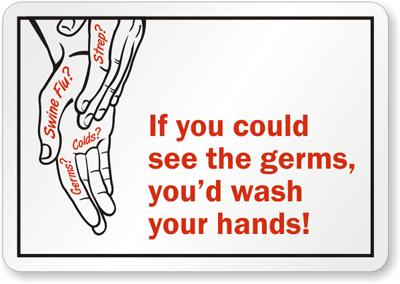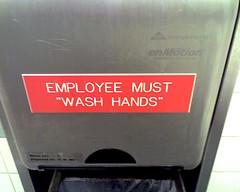Washing your hands is one of the most effective ways to prevent the spread of infectious diseases. This post will clarify The Art and Science of Washing Your Hands so that you will know just what it takes to ensure that you stay happy and healthy!
Why is it Important
The Center for Disease Controls has stated that dirty hands contribute to nearly 50% of all foodborne illness outbreaks! Our hands often touch high contact areas like door knobs, ATM machines, gas pumps, stranger’s hands, pets, garbage cans, & more! Just imagine how many germs are on your palms at any given time!
Tip: Try using a black light to see just how dirty your hands are. We warn you, what you find may surprise you!
Be sure to watch this short clip issued by the CDC to learn what you can do to avoid catching the flu!
Statistics
A recent study by Michigan State University has released some astonishing findings about hand-washing practices. Researchers based their findings on a study that observed 3,479 individuals. The study found that a whopping 95% of people do not wash their hands long enough to kill harmful bacteria! University Professor Carl Borchgrevink remarked, “These findings were surprising to us because past research suggested that proper hand washing is occurring at a much higher rate.”

Contaminated hands are dangerous! (via: www.justbathroomsigns.com)
Average users only wash their hands for 6 seconds while a mere 5% wash their hands for the recommended 15 seconds or longer. 15% of men didn’t wash their hands at all while only 50% used soap. In comparison, 78% of women used soap and 7% didn’t wash their hands at all!
Researchers were also able conclude that people are less likely to wash their hand when the sink is dirty. People are also more likely to follow proper hand washing guidelines when there are signs posted that remind bathroom users to wash before they exit!
Kaspars Jursons STAND Urinal/Sink
A European designer named Kaspars Jursons has attempted to address unsatisfactory hand-washing practices of men by creating a new Urinal-Sink called STAND. STAND comes with a built-in tap and a hands-free sensor activated function. Jursons aims to make hand-washing more convenient for men by locating the sink above the urinal. We are not sure whether the public will embrace this innovation or not. To see more details of Jursons STAND, Click Here to Visit their Homepage.

Signs encourage hand washing. (via: The Scott)
When you should wash your hands:
• Before, during, and after you prepare food.
• Before you eat.
• After using the restroom.
• After changing a diaper.
• After blowing your nose, sneezing, or coughing.
• When caring for someone who is sick.
• After touching garbage.
Proper Hand Washing Techniques
• Begin by wetting your hands with warm or cold water and apply soap.
• Next, rub your hands together vigorously to create a lather. Scrub all surfaces of your hands including the back of your hands, wrists, and between your fingers.
• Continue scrubbing for at least 20 seconds or about the time it takes you to sing “Happy Birthday” twice.
• Rinse your hands and dry them off with a clean paper towel, clean towel, or air dryer.
• Use a paper towel to turn off the faucet and open the door. This will allow you to avoid contact with areas that have high concentration of bacteria.
• When you don’t have soap, alcohol based sanitizers offer a quick alternative.
For more information on hand washing, we encourage you to Visit the CDC’s Hand-Washing Page to learn more about The Art and Science of Washing Your Hands. You can also email them specific questions to [email protected].
About this Post
Cheryl Khan is and interior designer and freelancer who tries to follow proper hand washing guidelines. She always carries a bottle of hand-sanitizer in her purse to maintain good personal hygiene!
